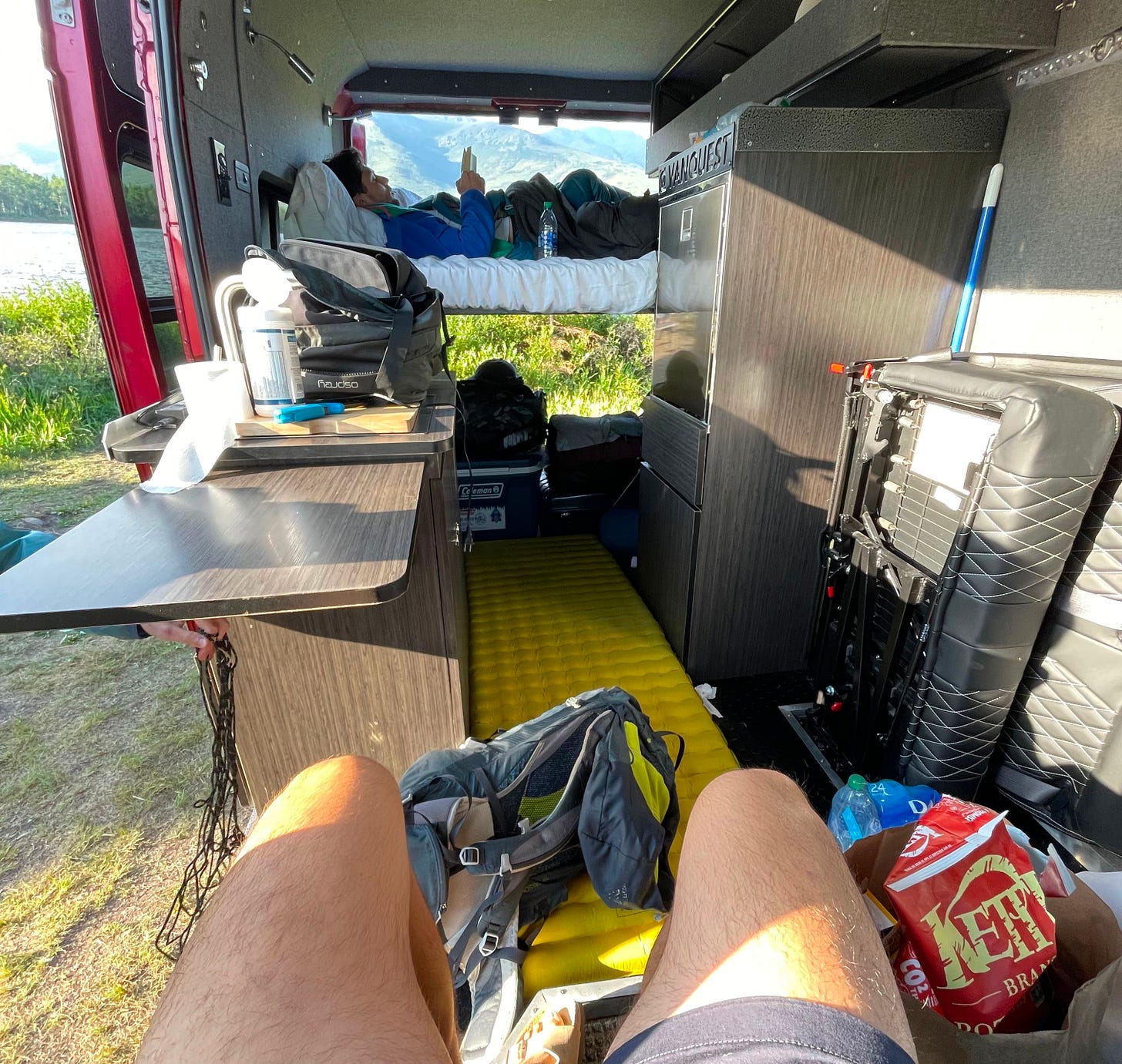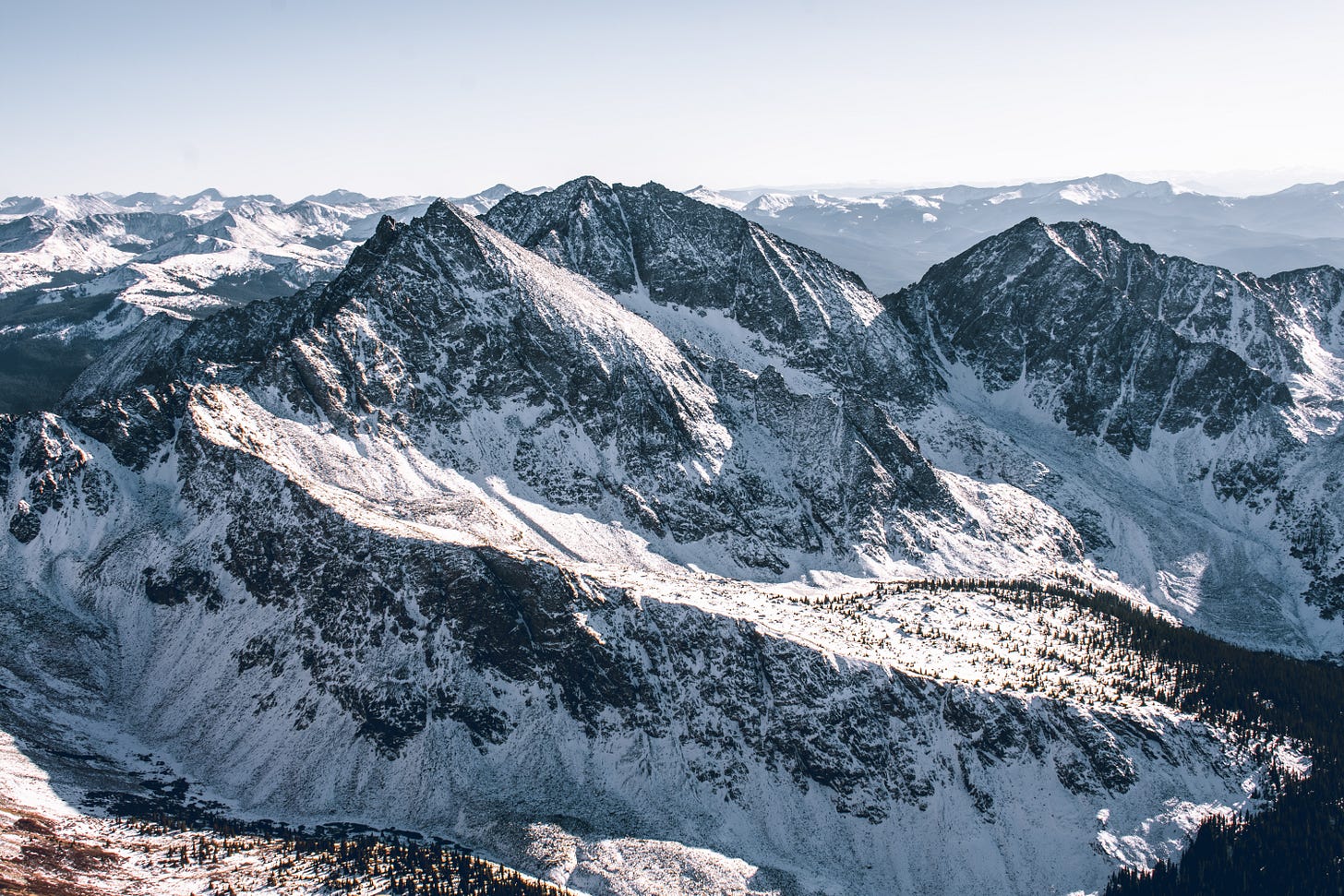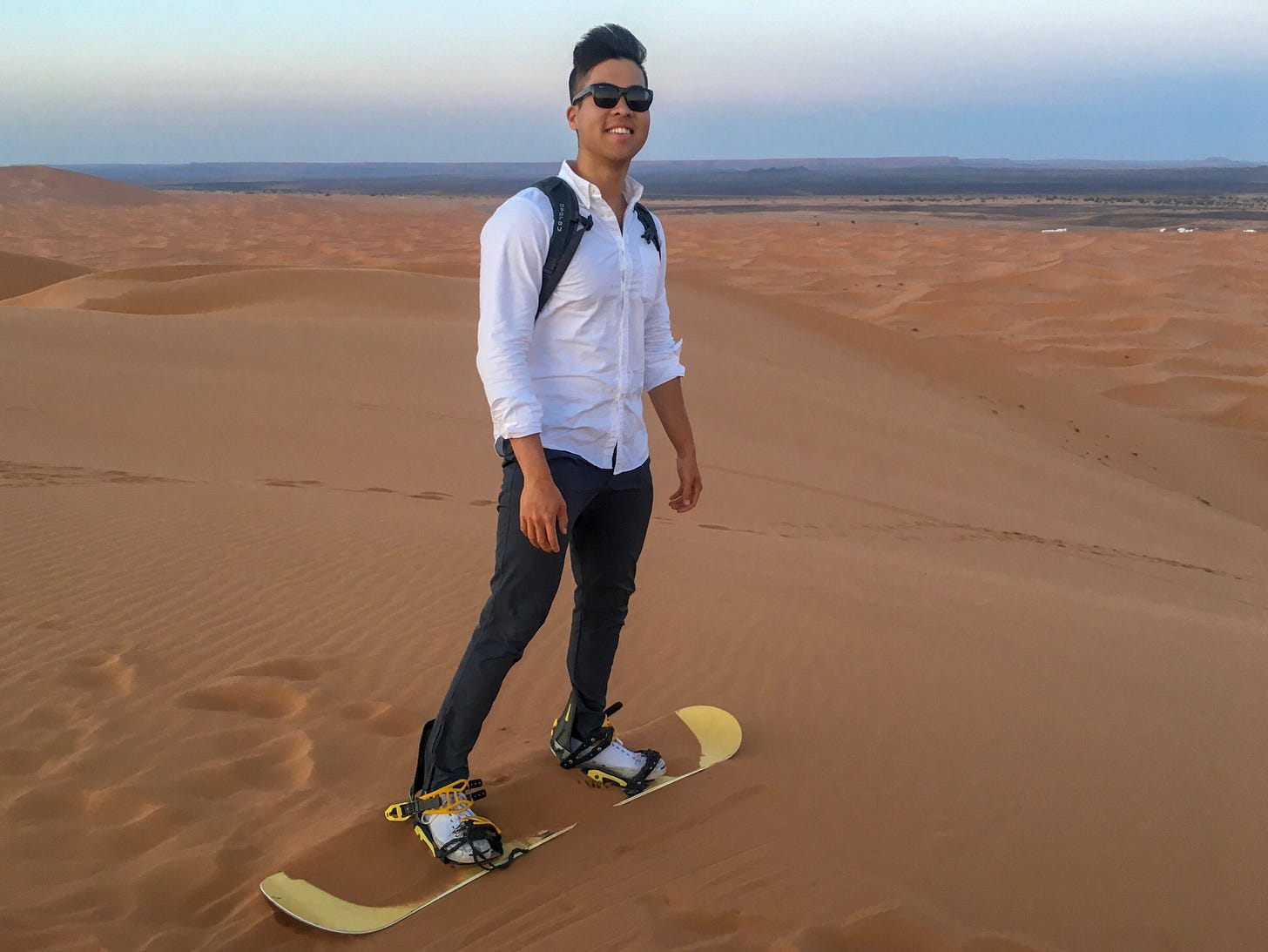Young Person Energy
grandpa advice from a 28 year old
There’s a small, perfect window where you’re old enough to have made some money, whether through internships or your first job, and where you still have this almost reckless amount of energy. It’s such a rare thing, to have the independence of an adult, the lack of responsibilities (and expectations) of a fully grown adult, and still have the energy of a hummingbird meets hamster that just shotgunned a can of cold brew.
Young Person Energy exists in all of us, lying dormant through our teens. But starting in college, with the help of a side job or internship, it becomes unleashed. When you’re without cash, you’re just dreaming, and without the freedom, you’re stuck at home. But once both conditions are satisfied, previous fantasies become possible realities.
Young Person Energy isn’t a strictly physical energy. It’s the type that allows you to wake up at 4:30am, drive 3.5 hours to Tahoe to catch first chair when the ski resort opens, ski all day until 4pm, drive back, stop for In-N-Out (two double-doubles, plus a protein-style hamburger for health), and then stay up until 3am partying.
Or the energy to backpack Southeast Asia with five other dudes for three weeks, changing hostels every 1-2 nights, riding mopeds by day and slamming Bintangs by night — blasting your mind with novel experiences.
Looking back, it’s impressive how insistent I was on chasing stoke and living life on my own terms. During the summer of 2021, I spent a week in Alaska with three friends. The four of us shared a camper van with two people on the thin mattress topper, one on the floor, and the last guy in a tent pitched on the roof. We backpacked in Denali National Park and none of us had actual backpacking backpacks. We each had normal backpacks bursting at the seams, with bulky sleeping bags dangling from the back.
I’m currently at the Stanford library, having settled into a more routine life. It’s the first time in a while that “routine” has a positive connotation. I’ve happily signed a lease, moved to the suburbs, and haven’t felt the itch to travel since we moved here. I’m also nursing a strained back, a function of not stretching and pushing too hard physically, but perhaps the physical pain reminds me that I no longer have Young Person Energy.
Young Person Energy
Young Person Energy (YPE) is what comes after puberty. As teenagers, we went through rapid physiological changes like acne, changing voices, and growing bodies. YPE isn’t as noticeable because it’s less of a physical transformation and more of an internal drive. Before we got co-opted into corporate life and sedentary lifestyles, we all had this pull that made us want to travel the world, talk to strangers, and climb trees.
YPE is the craving for adventure, and, most importantly, the willingness to put up with the discomfort, late nights, and wildness of it all. Some people preserve it. For most of us, whether it’s work’s stranglehold or the process of starting a family, our YPE gradually declines.
The people I admire most lived full adventures and then gracefully shifted into parenthood, while still doing cool shit. Doing both requires rapidly shifting identities. There’s nothing really stopping you from going all out on adventures until you become a parent, unless your desires shift first. From adventure-seeking honeybadger with YPE flowing through your veins to being completely content with stability.
The window where YPE peaks may never come again with such perfect conditions for adventure and novelty. It will become much harder later on, requiring higher activation energy, or you simply won’t want that type of life anymore.
I’m writing this because I feel nostalgic for that window in my own life. I’m almost certain it’s not coming back in the same form. But I’m still finding ways to keep YPE alive, like instead of spontaneous month-long adventures, I’m going on shorter trips that still pack the same punch. Through this perspective of someone just barely on the other side of peak YPE, I hope you’ll understand how precious this time window truly is while you’re in it.
My YPE Experience
I know this window is precious because I’ve seen what happens when it closes. You see, I coach people both younger and older than me. The younger ones wrestle with the same questions about life and work that I faced. But the older ones? They’re facing those exact same questions, but with more financial resources, more ingrained patterns, less willingness to try new things, and greater responsibilities. Years of prioritizing money, achievement, and status over adventure, connection, and purpose build up into a kind of sludge that’s hard to wash off. The contrast is stark. In almost all cases, the mid-life crisis hits much harder than the quarter-life crisis.
That’s why I’m grateful that when I was in my window, I made the conscious decision to put life first and job second. In 2020, through getting laid off from Uber with just ten months of work experience, I learned the tough but effective lesson of figuring out what actually matters.
Within weeks of starting the new job, I’d already organized a road trip to Park City with friends. It was August 2020, no lease, my first time living with people other than family since the pandemic. On our last night, we cooked a feast of steak, shrimp, sides, and desserts, sharing it all across a long wooden table. Then I drove to Denver for a two-week National Park road trip with my friend Jon. We’d do our jobs, drive a few hours, and squeeze in a hike, all before sunset.
I still remember our day trip to hike Mt. Huron, one of Colorado’s 14ers. With six dudes in one car, one guy voluntarily laid in the trunk of my SUV while cradling a leftover burrito from the night before. The last ten miles to the trailhead were unpaved gravel and you could hear him groaning in the back as we drove into ditches and over rocks. It was late October, and summiting 14ers was already not advised due to potential snowstorms. Two guys stubbornly wore shorts, like the boyish stubbornness I had in third grade when I would wait for the bus in basketball shorts while it snowed. We’d gone out to bars the night before, and that probably played a role in a couple guys throwing up around the 13,000’ mark. On the way down it got dark and we hiked the last couple miles completely in the dark. When we got back to the car, we all screamed with joy — safe, satisfied, and exhausted with joy.
That winter I organized a monthlong Airbnb in Frisco, Colorado, surrounded by dozens of ski resorts. At first, I practiced restraint and worked the standard 9-5, but the fresh powder was too tempting. Through some sneaky experiments, I learned that if I skied mornings from 9am-noon, I could still make it back with plenty of time to shower and scarf down lunch while beginning the work day. The mountain was quiet; all the other skiers were predominantly rich, old white dudes that seemed to have had successful careers and still knew how to have fun. I had tasted luxury without having the money yet and I couldn’t forget what it felt like.
Despite all the adventures and deliberately skipping work in the mornings, I was still putting in a ton of effort at work. I’d often work until 8 or 9pm and mentally I was still committed to doing a good job. Fast forward a few months and I got promoted to Senior Product Manager with less than two years of full-time experience. The job supported my adventures and the adventures fueled my work. Whether intentional or not, I made some big tradeoffs, like living without a lease, owning very little possessions, and basically not dating at all — only in hindsight were those all worth it.
From there, I continued to anchor my winters around skiing, choosing adventure over stability. Without the responsibilities or the sludge that comes with a mortgage, I could keep living as someone who hadn’t learned to say no possibility, with the benefits of location freedom and a solid paycheck. The annual ritual of migrating to mountain towns reinforced that life comes before work. I started to see how I could transform my life if I defiantly questioned the norm and curiously stepped into the realm of possibilities.
From 2021 to just a few months ago, I lived between Hawaii, NYC, ski towns, and the Bay Area where my family lives. Being in Hawaii continued to show me bite-sized glimpses of alternate realities. I got into surfing and yoga, and made new friends that didn’t ask me “What do you do for work?” as the first question. As I lived seasonally between tropical islands, snowy mountains, and tall skyscrapers, the stark contrast between each place helped me triangulate on what I wanted my days to look like. Over time, I noticed the growing desire for more stability and the waning youthful energy to always be adventuring.
That leads me to where I am today. In some ways, perhaps because of the recent shift to living permanently in Palo Alto, I feel like a grandpa. I like sleeping in the same bed every night and having the same morning routine. Instead of setting my alarm for 5:30am and mainlining caffeine before surfing at sunrise, I walk around the park and read books. I used to cram my days back-to-back with activities. I’m still getting used to having free time on a random weekday and not having the urge to fill it with some activity.
Grandpa Advice
Part of feeling like a grandpa at 28 is this impulse to share what I’ve learned. Not because I know something that others don’t, but because I’m still close enough to remember it vividly, yet far enough away to notice what I couldn’t see when I was in it.
I want to understand why the time window when YPE is at its peak is so precious.
To start, having YPE allows you to go on Big Adventures. These aren’t just ambitious goals. Running a marathon is ambitious, but the entire playbook is documented online. Starting a startup is ambitious, but if you’re doing it for the status — you’re missing the point. A Big Adventure has three key components: it’s ambitious, has no guaranteed outcome, and most importantly, you’re doing it for your own fulfillment. I’m talking about hiking the PCT, living in South America for months, biking across the country. You can’t analyze the ROI of these trips on a spreadsheet or ask ChatGPT to tell you if it’s worth it. These are experiences that are the antidote to watching short videos of other people telling you to buy random shit you don’t actually need.
Memory Dividends are what you get from Big Adventures, and rarely are they priced correctly. I still remember the feeling of accomplishment when we finally summited snowy Mt. Huron. Grilling salmon at a random park at 11pm as the sun was just starting to set in Alaska. Sandboarding down the dunes of the Sahara. These aren’t just fun stories I tell at parties. They’re memories accompanied by visuals, feelings, and energy that I can tap into and relive when my mind is particularly quiet. They’ve become reference points when I’m making hard decisions and reminders of what it feels like when I choose curiosity over comfort.
The thing is, you can’t properly value Memory Dividends until after the fact. When I was 25, I couldn’t have known how much that random Alaska trip would matter to me now. I wasn’t thinking about reliving potential memories in the distant future or how it would shape who I became.
Which brings me to Regret Asymmetry. I used to worry about falling behind in my career or not saving enough money. But then I realized: those things are all still available to me. I can focus on career next year. I can save more money in my thirties. But I can’t go back and be 24 with no lease and unlimited energy. That window closed already.
I’ve never met someone who regretted the adventures they took. Sure, hindsight is 20/20, but that doesn’t mean we can’t apply it to our lives right now.
So if you’re in your YPE window right now, take it from someone who lived without holding back and only recently slowed down. The safe, often more lucrative choices will always be there. The weird, wild, serendipitous ones won’t. Your present self will promise a better time later, a “someday” when the decision looks good on paper. That day does not come. I’ve watched friends with bigger titles and bigger paychecks miss it. I would still choose the same path.
And if you think you’re past the window like me? I’m actually learning that YPE doesn’t actually die or disappear. It just gets buried under routines, comfort, and responsibility. I can still feel it sometimes, like when my friends and I are planning something unnecessarily fun, or when I’m able to recreate a miniature version of YPE on the basketball court or on the jiu jitsu mat.
I keep thinking about those rich old dudes skiing powder on weekday mornings back in Frisco. They weren’t trying to be young forever. They’d built successful careers but refused to let those careers build them into someone who forgets what powder days feel like. They learned to carry YPE alongside the rest of life’s demands.
Because YPE isn’t about age or having no lease or unlimited energy. It’s about protecting that part of you that knows some experiences can’t be justified with reasoning. The part that wakes up at 4:30am to catch first chair at Tahoe, even when you have every reason to sleep in.
Maybe writing this whole essay has been my way of reminding myself not to let go of it. Not to stay young forever, but to remember what it felt like to trust curiosity more than comfort. To keep finding ways back to that feeling, even from my grandpa life in Palo Alto.
The window of peak YPE might close. But it’s still there, waiting for us to tap into. We just need the creativity to access it, the courage to choose it, and the desire to chase it.
P.S. I’m a coach.
I help ambitious people reconnect with their YPE. If that sounds interesting to you, learn more here.






I read this a few days ago and found myself thinking about what you wrote over the weekend (good job!) The reason it stuck with me is because while I understand what this essay is getting at, some of us didn't have the luxury of simultaneously being in early-to-mid 20s while making a lot of money. For me personally, it was a mix of having no idea what I wanted to do with my life and then starting grad school, both of which kept me low on the obligation scale, but also fairly broke. For others it may have been difficulty finding a job, crippling debt, caregiver responsibilities, etc.
Currently in my mid 30s, I can definitely say that this "YPE" that you speak of is much more relatable now. Yes, I am married and yes I have a mortgage, but my husband and I are also "DINCs" living in Boulder. But what's troubling me is this feeling that based on what you've written, I missed some specific experience in my 20s and it's impossible for me to go back and re-do it. I have this nagging frustration that this article is so narrowly tailored to such a small set of people and those of us beyond this phase of life are screwed or missed out.
So perhaps the more interesting question is, how can we bring more YPE into our lives at any phase? Whether we're in our 30s, parenting in our 40s, climbing the corporate ladder, making a career pivot or adjusting to the next phase of life.....after all, isn't YPE just a state of mind and an attitude towards life?
It's impossible to change the past, so rather than harp on the fact that my 20s doesn't match the epic experience you write about, I'm much more interested in focusing on how to make sure I'm living deliberately and intentionally in the present.
Dude this was great. Really thoughtful reflection and it really made me think. Those sound like some incredible times…
My story is basically flipped. I had some travel adventures 21-23,
then lived in LA for seven years, focused on Write of Passage (plus covid hit etc). Now at 32 I feel absolutely brimming with YPE, in the midst of several (productive) Big Adventures. I’m not a never-grow-up type, I want to get married and have kids, sooner than later. But I’m fully embracing it for now (writing this at 11:45pm from a bar/care in western China). I guess we’re all on different timelines for these things
In my seventh year of living in Santa Monica, I clearly remember seeing a post of yours about surfing in Lombok. The palm trees, hammocks etc. Something about it stopped me in my tracks, made me want to get back over to Asia, re-open that adventurous chapter. And today I just spent the day at a lake in China with a somewhat similar setup.
Anyways, I’ve always appreciated that nudge you inadvertently gave me via that post